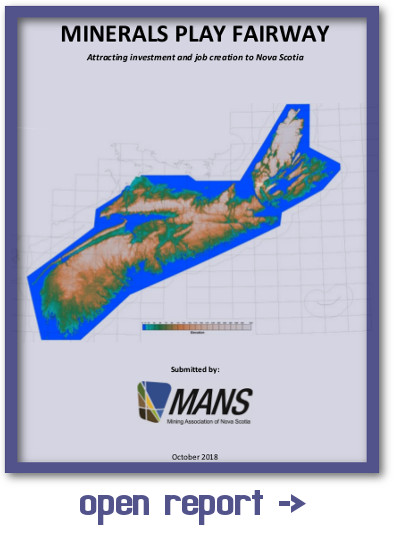Minerals Play Fairway
Nova Scotia’s mining and quarrying industry is seeking $19.5 million in government funding for an airborne geophysical survey program. The project, called Minerals Play Fairway, would improve our geological understanding of Nova Scotia, help find future mines and quarries, and be an essential tool for attracting investment and job creation to the province.
Minerals Play Fairway is modelled on the highly successful Nova Scotia oil and gas Play Fairway Analysis. In 2008, the Department of Energy commissioned a $15 million Play Fairway Analysis and geoscience data package program with the goal of stimulating offshore petroleum exploration activity. The resulting data was made available for free to the global oil and gas industry and attracted over $2 billion in investment in Nova Scotia’s offshore.
This needs assessment report is the first step toward building a minerals version of Play Fairway – a free, best-in-class database of geophysical knowledge that will help attract investment and job creation to Nova Scotia. The oil and gas Play Fairway was a made-in -Nova-Scotia success story and copying it for the mining industry would help the industry grow and create jobs for Nova Scotians. The needs assessment analyses the province’s publicly-held airborne geophysical data and recommends that government fund a series of geophysical surveys:
- A province-wide magnetic, radiometric and VLF survey;
- A regional gravity gradiometry and magnetic survey in the St. Mary’s Basin and Cobequid-Chedabucto Fault System; and
- A series of regional electromagnetic (ZTEM) surveys.
Nova Scotia’s mining and quarrying industry employs 5500 Nova Scotians, mainly in rural areas, and generates $420 million per year in economic activity. Fostering mineral exploration is essential to ensuring the industry’s ability to keep creating new jobs for Nova Scotians. If we do not do exploration today, there will not be new mines tomorrow.
Other Benefits of Geophysical Data
While Minerals Play Fairway’s main focus is to help find mineral deposits and attract investment to the province, there are several other ways in which Nova Scotians would benefit from the geophysical survey program detailed in this report:
- There are many different types of chemical and physical geohazards in Nova Scotia that have the potential to place the public and infrastructure at risk. The sinkhole in Oxford’s Lions Club park is a recent example. Deadly radon gas is another. The data from Minerals Play Fairway could be used to help identify potential geohazards and protect Nova Scotians from them.
- The geophysical data generated by the Minerals Play Fairway could also help identify potential deposits of onshore oil and gas and complement the Department of Energy and Mines’ recent Nova Scotia's Onshore Petroleum Atlas project (2013-2017).
- Geophysical data can also be used to help find and delineate aquifers. Increasing our knowledge of Nova Scotia’s aquifers would help improve water management, especially given potential impacts on our water supply caused by climate change.
Improving our geophysical knowledge of the province would lead to improved safety, economic opportunities and better land, water and environmental management.
Partnership with Government
The partnership between the mining industry and the Government of Nova Scotia has been very successful in recent years. Government policy decisions - including extending the fuel tax rebate to the industry, the Mineral Resources Act overhaul, and the establishment of the Mineral Resources Development Fund – have helped the industry grow and create jobs for Nova Scotians. We believe Minerals Play Fairway is an opportunity to continue to build on this success and the industry/government partnership that has already accomplished so much.




